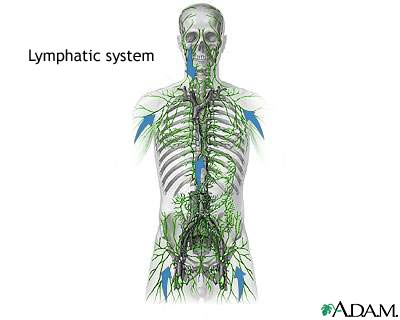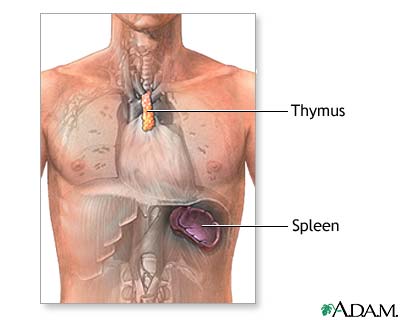|
|
|
|
|
Navigation links
As blood circulates, some of its fluid components push out of the capillary bed into the surrounding tissue. This material forms lymph, a special protein-containing tissue fluid that bathes the cells. Lymphatic vessels reabsorb part of this lymph to return it to the circulation, thereby maintaining tissue fluid balance. The lymphatics also engage in absorption of fats and other substances from the digestive tract. Lymph node structures along the route of the lymphatics filter out foreign materials and disease-causing agents from the general circulation. Other lymphatic system structures include the tonsils, spleen, and thymus.
Capillary hydrostatic pressure: fluid diffusion and reabsorption Capillary hydrostatic pressure (filtration pressure) forces fluid out of the blood capillaries. Hydrostatic pressure results from the heart forcing blood through the narrow arterial part of capillaries. The fluid contains oxygen and nutrients that move into the surrounding tissue where they are less concentrated. Similarly, the tissue contains carbon dioxide and waste products that move into the capillaries where they are less concentrated. This process of substances moving from areas of higher concentration to areas of lower concentration is diffusion. Fluid reabsorption begins in the lymph capillaries that are throughout the body near blood capillaries. Lymph capillaries are small microscopic tubes that collect extracellular fluid. The walls of lymph capillaries comprise loosely joined cells. The overlapping edges of the cells form mini-valves that allow extracellular fluid to pass into the capillary and prevent fluid from flowing back into the tissue. Unlike blood capillaries, lymph capillaries are blind-end tubes that lead away from the tissue. Lymph travels through the lymph capillaries to small lymph vessels. Like veins, the walls of lymph vessels have smooth muscle that contracts and propels lymph away from the tissues. Lymph vessels contain valves that prevent lymph from flowing backward. The lymph vessels converge into two main collecting ducts: the shorter right lymphatic duct and the longer thoracic duct. The right lymphatic duct drains lymph from the right side of the head, neck, thorax, and right upper extremity into the right subclavian vein. Lymph from the rest of the body flows into the thoracic duct that empties into the left subclavian vein. The thoracic duct begins in the abdomen as an expanded sac called the cisterna chyli. When lymph empties into the veins, it forms plasma (the liquid part of blood). Lymph organs: nodes, nodules, spleen, thymus gland, tonsils The lymphoid organs are the lymph nodes, spleen, thymus, and groups of lymph nodules in both the oral cavity (tonsils) and small intestine, and appendix (Peyer's patches). A connective tissue capsule surrounds the lymph nodes. The nodes have an outer cortex and inner medulla. Within the medulla is the germinal center that produces lymphocytes. These infection-fighting white blood cells produce antibodies that identify and destroy antigens.
Designed like filters, lymph nodes remove antigens (foreign bodies) from lymph. Each lymph node has several sinuses (inner chambers) that contain lymphocytes. Lymph nodes also contain macrophages that help clear the lymph of bacteria, cellular debris, and other foreign material. Macrophages attack, ingest (engulf), then kill antigens in a process called phagocytosis. Small extensions of the macrophage pull the antigen inside. 
Lymph nodules are groups of lymphocytes arranged in round clusters. Many lymph organs contain lymph nodules within their substances. Unlike lymph nodes, they cannot filter lymph. The spleen is the largest lymphoid organ. It has two types of tissue: the red pulp, which contains many red blood cells (erythrocytes) and macrophages; and the white pulp, which stores lymphocytes. The macrophages in the red pulp remove foreign substances and damaged or dead erythrocytes and platelets from the blood. And, the red pulp stores platelets, which are important for blood clotting. The lymphocytes within the white pulp are used for the body immune system.
In the thymus gland lymphocytes become specialized. The thymus plays an important role in lymphocyte specialization and immunity. The tonsils are paired lymph nodules in the oral cavity. These patches of lymph tissue produce lymphocytes. The location of each pair (palatine, pharyngeal, and lingual) determines its name. The tonsils protect the throat and respiratory system. Sometimes, the tonsils cannot remove all the invading microorganisms and become infected. If the infection is severe and chronic, the tonsils may require tonsillectomy (surgical removal).
|
Any duplication or distribution of the information contained herein is strictly prohibited. The information provided herein should not be used for diagnosis or treatment of any medical condition and is provided for your general information only.



